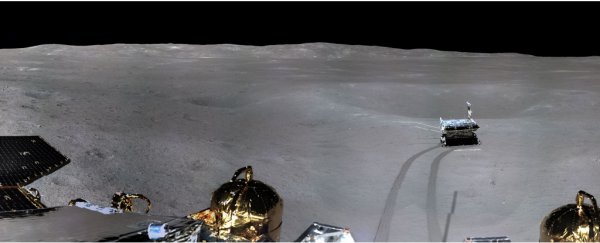The far side of the Moon is a strange, barren, monochrome place, according to the latest images sent home from China's Yutu 2 rover. An incredible 360-degree panorama reveals just how arid and alien it is on the back of Earth's satellite.
China made history when spacecraft Chang'e 4 landed rover Yutu 2 on the Moon's far side on January 3 - the first successful landing on the mysterious crater-pocked surface.
The rover was deposited in the Von Kármán crater, in the much larger South Pole-Aitken Basin - an absolutely huge impact crater (one of the largest in the Solar System) that constitutes nearly a quarter of the lunar surface, at 2,500 kilometres (1,550 miles) across and over 8 kilometres (5 miles) deep.
 (CNSA)
(CNSA)
Currently, the lander and rover are at an altitude of about -6 kilometres (-3.7 miles), that is, six kilometres below the point of zero elevation as defined by the average diameter of the Moon, since it doesn't have sea level.
The devices will use ground-penetrating radar to take measurements of the Moon's interior, and cameras and spectrometers to study the composition of the lunar surface, communicating with Earth via a relay satellite - radio signals can't travel through the Moon.
"The information from the depths of the Moon will be one of our focuses in the exploration," Li Chunlai of the National Astronomical Observatories of China told Xinhua.
Since the landing, the team at the China National Space Administration has been putting rover Yutu 2 and the lander through their paces.
They have successfully completed the relay link, payload start-up, going to sleep and waking up again, two-unit separation and "two-way mutual shooting" - the lander and the rover taking photos of each other.
 (CNSA)
(CNSA)
And, of course, they photographed their surroundings.
"From the panorama, we can see the probe is surrounded by lots of small craters, which was really thrilling," Li said.
This means that scientists navigating the rover will have to be careful not to let it crash into one of these craters, which are much more numerous on the far side of the Moon - possibly because later volcanic activity on the near side covered many of its craters in basalt plains.
Conversely, though, the far side has fewer rocks and much more dust, which was seen puffing up in a video shot by Chang'e 4's landing camera as the lander touched down.

"The thicker dust shows that the lunar regolith in the region has undergone longer space weathering, which also gives strong evidence of the region being older," Li said.
In addition, the Chang'e 4 lander contains a small biosphere, carrying tomato seeds and thale cress seeds, the latter being a popular plant for scientific experiments, as well as silkworm eggs, to determine how well these species grow on the Moon - if they grow at all.
According to the CNRS, Chang'e 4 will be ready to start doing science once the engineering test has been successfully completed.
Meanwhile, the full panorama of the landing site can be viewed here.
